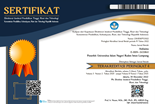Adaptasi Alat Ukur Psikologi Motivation Achievment Inventory Dengan Metode Confirmatory Factor Analysis (CFA)
Abstract
This study measured 32 items of achievement motivation variable in an undimensional manner which was adapted from Muthee and Thomas (2009) into Indonesian language and culture by involving peer review to reduce the effect of bias. The procedure for adapting measuring instruments through the stages proposed by Beaton et al. (2000), the first stage is translation. The first translator is mastered in English and the second translator had competence in the field of Psychology and English. Second, is the synthesis of the translation results, back translation, and a committee review of experts. Questionnaires were distributed to 102 MA Darussunnah students, Ciputat, South Tangerang. All items were analyzed using Confirmatory Factor Analysis (CFA). The results showed that 32 items were undimensional. This means that all items only measure one factor, so the one-factor model contained in the Motivation Achievement Inventory can be accepted. Of the 32 items, there were 15 items that were invalid, so they were dropped. That is, only 17 items that measure the achievement motivation variable.
Keywords: Motivation Achievement Inventory, Adaptation, Confirmatory Factor Analysis (CFA).
Full Text:
PDFReferences
Azwar, S. (2012). Penyusunan Skala Psikologi (II). Pustaka Pelajar.
Azwar, S. (2016). Reliabilitas dan validitas (IV (ed.)). Pustaka Pelajar.
Beaton, D. E., Bombardier, C., Guillemin, F., & Ferraz, M. B. (2000). Guidelines for the process of cross-cultural adaptation of self-report measures. Spine, 25(24), 3186–3191. https://journals.lww.com/spinejournal/Citation/2000/12150/Guidelines_for_the_Process_of_Cross_Cultural.14.aspx
Muthee, J. M., & Thomas, I. (2009). Achievement motivation inventory Kariavattom. In Trivandrum: Department of Psychology.
Umar, J. (2012). Analisis faktor konfirmatorik.
Subandi, (2011). Sabar: Sebuah Konsep Psikologi. Jurnal Psikologi, 38 (2), 215-227.
DOI: http://dx.doi.org/10.24042/ajp.v5i1.13349
Refbacks
- There are currently no refbacks.
Copyright (c) 2022 ANFUSINA: Journal of Psychology











